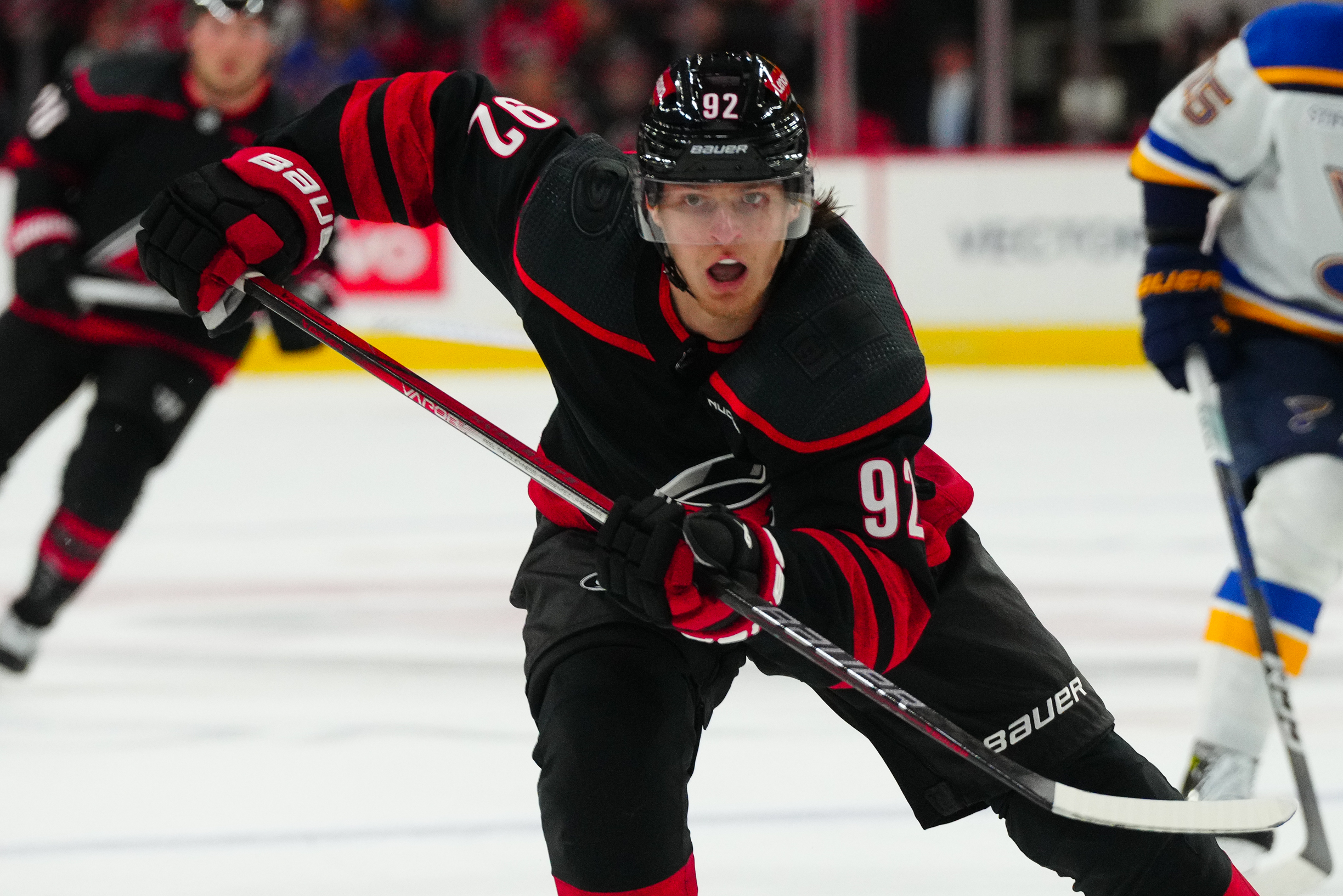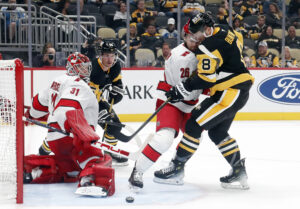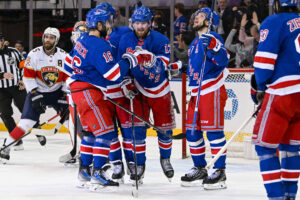With a few days off, we recently looked at some of the stories from the Carolina Hurricanes latest hot stretch of play that show their potential for this season and (hopefully) post-season. In Part 1 of this two-part series, we discussed some of the individual players and positions that were working for Carolina during that stretch. Now we turn our attention to more system-based and collective stories with a brief look deeper down the Hurricanes organization.
Carolina Hurricanes Positives Following Holiday Break Show Potential
As discussed in Part 1, the Hurricanes returned from the holiday break following a loss to the New York Islanders and started rolling. They put together a five-game win streak and six-game point streak. While their rocky season started turning around a little before the holiday break, this latest stretch truly showed the team’s ability and potential for this year and beyond. Not to mention some stories from Carolina’s up and coming players that give rise to optimism for the franchise.
Special Teams on Fire
If there was only one area that you had to pick as being almost automatic for Carolina during this stretch, it would be special teams. And both sides. Special teams have been fairly decent for Carolina this year, but it really took a turn during this stretch.
Putting the Puck in the Net….
Let’s start with the power play. Between opening night and the holiday break, Carolina’s power play was pretty good at 24.4%. This put it at eighth in the NHL. They scored 28 goals BUT had a league worst seven goals against on the man advantage. But after the holiday break, the power play almost seemed like as much of a guaranteed goal for Carolina as any other situation. They lead the league at 52.4% over that span. They also lead the league with 11 goals for on the power play with none against during that stretch.
Now up to 28.7% on the power play, the Carolina Hurricanes are hovering around top three in the league. With Carolina’s playing style, we previously discussed how important it is for them to have a lethal power play. And it is showing. During this stretch, the Hurricanes matchup with the New York Rangers started off with Carolina getting two power play goals in the first period. Against the Washington Capitals, the team went down early, tied it in the third period, and then took advantage of back-to-back power plays to win in regulation. The point is the power play has been a catalyst for much of Carolina’s offensive production.
What Gives?
Great power plays are marked by fluid puck and player movement. The power play works to create odd man matchups and open shots resulting from the penalty kill collapsing. But for many effective power plays, there is a play the team prefers. Think of Alex Ovechkin‘s one timer from the left circle or Steven Stamkos doing nearly the same for the Tampa Bay Lightning. Well Carolina may have found something that is starting to fit that pattern. Brent Burns will work the puck from the top of the point to Sebastian Aho at the left high spot on the umbrella. Andrei Svechnikov will slide down on the right side towards the dot or below and Aho will find him for a one timer. It’s more of a high to low diagonal set up than a straight side to side one timer. But it’s been working.
Andrei Svechnikov gives the Canes the lead late in the third! ? pic.twitter.com/3pjiiLdzet
— Sportsnet (@Sportsnet) January 6, 2024
When you get a play like this that starts working over and over, teams will start looking to defend it. So, the “phase 2” of the successful power play is to then be able to score elsewhere while the penalty kill fixates on the “go-to” plan. Carolina has found this in many ways including bumper passes from below the goal line and traffic in front while Burns booms a shot. Even if the power play cannot keep up this high rate of success, it could be a huge part to this team’s success and potential this year. Of course, as seen in the St. Louis game, if they don’t get many power plays it won’t do much. (They were one for one in that game on the man advantage.) But when they do, being opportunistic will be key.
Brent Burns on hatty watch! ? pic.twitter.com/J5PWDqKUmu
— Sportsnet (@Sportsnet) January 6, 2024
And Keeping it Out…
But it wouldn’t be fair to only point out the power play’s success over this span. The penalty kill has been a strong point of this team for years. And this year is no different, even if it isn’t as dominate overall as it was last season. The team is at 82.8% on the penalty kill this year which is still good enough for top ten in the league. But unlike the power play, the penalty kill has been more of a slow and steady riser for Carolina than a major jump.
Before the break, Carolina’s penalty kill was 82.7%. For the stretch after the break, Carolina’s penalty kill was 83.3%. They only let in three goals on the kill and added one themselves over that span. The kill is still doing what it typically does in working hard and playing aggressively down a man. When done well, the penalty kill can suffocate the other team’s power play breakout before even entering the zone. While there is still room to improve, the kill has been solid and reliable. And again, shows that while the team has exploded on the power play, they have not sacrificed their strong penalty kill.
Team Depth
While in Part 1 we looked at the team’s star power of Aho, Svechnikov and Burns, this team would not be where it is without its depth providing support and producing. And this is coming from almost everywhere it seems.
Depth Scoring
On the offensive side, depth forwards Jack Drury and Stefan Noesen have been a formidable pair. We have previously discussed them both individually in separate articles.
They both play a responsible two-way game on the fourth line and aren’t afraid to throw the body. If needed, they can slide up the lineup too. But they both also are producing offensively. At 5v5 over the last six games (keeping in mind that Noesen missed one), Drury and Noesen when playing together have had two goals for and none against. But then they both are getting time on the power play as well. Drury had one goal and three assists on the power play over that span.
But then you add in a few goals from Jesper Fast, one from Jordan Martinook and reliable play from Brendan Lemieux and the rookie Vasiliy Ponomarev and the depth is helping push the team forward. Lemieux had a great setup play to Michael Bunting against the Rangers and Ponomarev scored his first NHL goal and NHL assist against the Washington Capitals. This shows that while injuries ideally should be avoided, there is some depth in Carolina amongst its forwards. But it also shows that players like Ponomarev are able to help now and even further down the road (see more below).
Defensive Depth
On the defensive side, outside of Burns, Brady Skjei has been quietly one of Carolina’s best defencemen all season. He had three assists over the latest six-game stretch but continues to provide the team with a very good top four defenceman who can drive the play, produce offensively, and protect the net defensively. And for the season, Skjei leads all Hurricanes defencemen in points with 24. He has been utilized on the power play as well as shorthanded, even having a shorthanded goal this year. Following a career year last year, Brady Skjei has made himself a cornerstone piece of Carolina’s defence.
But one big thing that has changed to really solidify Carolina’s defence that started the year rocky is the emergence of the chemistry of the bottom pairing of Dmitry Orlov and Jalen Chatfield. They are skating hard, making plays, and seeming to find some rhythm in all three zones of the ice. Neither of them mind playing physical or shooting the puck.
Together they have two goals and one assist since the holiday break. Playing almost 80 minutes together over that stretch, they have two goals for and two against. These are compared to their 2.82 expected goals for and 3.17 expected goals against. For the year they are pushing the top ten in defensive pairs playing at least 200 minutes together for expected goals against per 60 minutes at 2.04. As far as that stat over this six-game stretch, a close 2.41.
The point here is much like the penalty kill above. This pairing started its solid play before the holiday break, but importantly carried it through. With an arguably elite top four, solidifying the bottom pair is just as important as Burns putting up points. This pair was hurting the team at the beginning of the year. But as of late, that is not the case anymore. While another reliable depth defenceman may find his way to Carolina, the top six looks like the top six for now and down the road this season.
Speaking of “Potential”
And while we are talking about potential, Carolina also is seeing success “down on the farm.” One obvious example was Ponomarev’s excellent play in the two games he suited up for with Carolina. Getting a goal and an assist in his first game is nothing to balk at. But his overall game really stood out. He was always known as a reliable two-way, “meat and potatoes” type player. And he continued to show that in his first stint. This provides Carolina with a call-up option this year as well as a potential fixture in the forward lineup down the road. Or, it may provide a more valuable trade piece. But while Carolina was finding success on NHL ice, some of its prospects were also showing some sparks over that span.
World Junior Championship Medals
Most know that while Carolina was on their recent run, the future NHL stars were in action in the World Junior Championships in Sweden. Carolina had two prospects in that tournament. And both medaled. Jakub Vondras was the backup goalie for Czechia but only made one appearance in the tournament. Ironically, it was coming in to relieve starter Michael Hrabal in the first period of the bronze medal game. After letting in a few goals, Vondrus looked sharp and led Czechia to a dramatic winning finish.
More notable during the tournament was Carolina’s 2023 second round draft pick in the Swedish Felix Unger-Sorum. The youngest eligible player of that draft started the year off impressing in Carolina’s training camp, almost making the team. He was then sent back to the SHL to develop but suited up for the silver medal winning Sweden in this tournament. Statistically, he put up six points in seven games. Notably, Unger-Sorum seems to have an insanely high hockey IQ on the ice. He can find players in prime scoring locations. But he also isn’t afraid to work down low to win pucks and is very strong on the power play. He showed all of this during this tournament. His patience with the puck to create space and set up plays was exciting to watch, and he could be an NHLer sooner than later.
Bradley Nadeau – Freshman Fever
Carolina’s first round selection of the 2023 NHL Entry Draft, Bradley Nadeau, continues to produce at a high level as a freshman for the Maine Black Bears. He is tied for seventh in the NCAA in goals per game with .72 after putting up 13 goals in 18 games. There were many questions about if he could translate his high scoring rate from the BCHL to the NCAA but he has seemed to silence the doubters so far. Bradley plays with his brother Josh Nadeau at Maine who was an invitee to Carolina’s prospect camp over the summer. Josh is also performing at a high level, making one wonder if Carolina takes a chance on another Nadeau.
Alexander Nikishin – Boom
There has been so much to say about Carolina’s top prospect Alexander Nikishin. Nicknamed “Boom” due to his physical play and heavy shot, Nikishin is showing he can do it all in the KHL. He recently hit 100 points with SKA St. Petersburg where he is the team’s captain at only 22 years old. Nikishin has 37 points in 48 KHL games. He continues to shine as one of the KHL’s best defencemen and is likely already NHL ready. Due to complications with his contract in Russia, Carolina will have to be patient with Nikishin. But again, over the last stretch of play, we continue to see big things from Nikishin.
All of this is to say that Carolina finally has shown fans something to be excited for over this latest stretch of play. Of course, it will cool off and there are still areas that management could tweak to make the team more competitive. But these stories show that the Carolina Hurricanes have the ability to go deep in the playoffs with strong potential even further down the road. The question is if the management, coaches and players can keep up some resemblance of this high level moving forward.
Main Photo Credit: James Guillory-USA TODAY Sports






